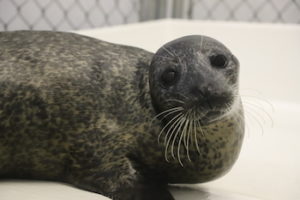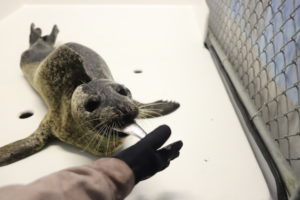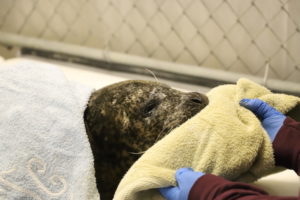 This time of year is usually slower in the field, and our center is usually empty in November and December—but this year we have one special case!
This time of year is usually slower in the field, and our center is usually empty in November and December—but this year we have one special case!
Meet patient #328, our stranding team’s 328th response of 2020. A harbor seal reported to our hotline last month in Cape Elizabeth, our response team found her emaciated, lethargic, weak, and laboring to breathe. Clearly in need of help, we collected and transported her to our center.
While #328’s symptoms are not uncommon and her species is the one we most often treat, her age-class is unique. Most harbor seals we respond to and treat are pups and yearlings, but at two-three years old, #328 marks the first live-stranded juvenile harbor seal reported to our hotline, let alone treated at our center.
#328 is a high-maintenance case, requiring lots of treatments and small, frequent meals. She is slow to improve and far from out of the woods, but she’s headed in the right direction. This big, beautiful seal has almost doubled her weight since admit, eating ten pounds of fish each day!
While in our care, we’re maximizing this rare opportunity to study and learn about a poorly represented age class in the harbor seal population. We’re working with labs and researchers around the country, collecting biological samples for disease surveillance, genetics mapping, and evaluating shark and seal occurrence in Casco Bay using environmental DNA.
Admitting and treating #328 will not only help this single seal return to the ocean, but it also helps to fill some extensive data gaps. We hope that her path to recovery will ultimately lead to her release; as that day draws closer, we anticipate seeking funds to fit her with a satellite tracking tag so we can learn even more about her and her habitat use.
Stay tuned for updates on her progress. For more on her story, follow Marine Mammals of Maine on Facebook and Instagram!
 |
 |
 |
